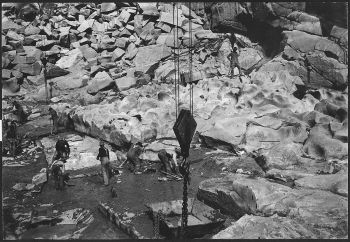Rock Foundations: Difference between revisions
(Created page with "__NOTOC__ Category:Foundation Evaluation ---- <!-- Delete any sections that are not necessary to your topic. Add pictures/sections as needed --> Rock foundations provide a stable and durable base for the dam structure. The foundation must be capable of withstanding the applied loads, including the weight of the dam and the forces exerted by the reservoir water. They prevent excessive settlement, reducing the potential for sliding or toppling, and minimizing the r...") |
No edit summary |
||
| (2 intermediate revisions by the same user not shown) | |||
| Line 2: | Line 2: | ||
[[Category:Foundation Evaluation]] | [[Category:Foundation Evaluation]] | ||
---- | ---- | ||
{{Picture | |||
<!-- Add image file name (ex.image.jpg) --> | |||
|image= Pathfinder_Dam_bedrock_foundation.jpg | |||
<!--Add link if applicable --> | |||
|link= | |||
<!-- Add picture caption --> | |||
|caption= Construction of Pathfinder Dam's bedrock foundation. | |||
(Image Source: [https://commons.wikimedia.org/wiki/File:Pathfinder_Dam,_bedrock_in_foundation_-_NARA_-_294374.jpg National Archives and Records Administration]) | |||
}} | |||
<!-- Delete any sections that are not necessary to your topic. Add pictures/sections as needed --> | <!-- Delete any sections that are not necessary to your topic. Add pictures/sections as needed --> | ||
Rock foundations provide a stable and durable base for the dam structure. The foundation must be capable of withstanding the applied loads, including the weight of the dam and the forces exerted by the reservoir water. They prevent excessive [[settlement]], reducing the potential for sliding or toppling, and minimizing the risk of seepage or erosion. The design of the rock foundation aims to ensure the integrity and [[stability]] of the dam while maximizing its resilience to various external forces and geologic conditions. | Rock foundations provide a stable and durable base for the dam structure. The foundation must be capable of withstanding the applied loads, including the weight of the dam and the forces exerted by the reservoir water. They prevent excessive [[settlement]], reducing the potential for sliding or toppling, and minimizing the risk of seepage or erosion. The design of the rock foundation aims to ensure the integrity and [[stability]] of the dam while maximizing its resilience to various external forces and geologic conditions. | ||
| Line 10: | Line 20: | ||
The stability and resilience of the rock foundation are crucial for the overall stability and performance of the dam. A stable foundation ensures that the dam can safely resist external forces, including water pressures, [[seismic]] loads, and changes in reservoir water levels. The rock foundation also provides resistance against the potential for slope instability, uplift forces, and deformation. Proper foundation design, including excavation techniques, rock reinforcement, and [[grouting]], are essential for maintaining the stability and integrity of the dam, minimizing the risk of failures, and ensuring the long-term resilience of the structure. | The stability and resilience of the rock foundation are crucial for the overall stability and performance of the dam. A stable foundation ensures that the dam can safely resist external forces, including water pressures, [[seismic]] loads, and changes in reservoir water levels. The rock foundation also provides resistance against the potential for slope instability, uplift forces, and deformation. Proper foundation design, including excavation techniques, rock reinforcement, and [[grouting]], are essential for maintaining the stability and integrity of the dam, minimizing the risk of failures, and ensuring the long-term resilience of the structure. | ||
==Best Practices Resources== | |||
{{Document Icon}} [[Rock Foundations (EM 1110-1-2908)|Rock Foundations (EM 1110-1-2908), USACE]] | |||
{{Document Icon}} [[General Design and Construction Considerations for Earth and Rock-Fill Dams (EM 1110-2-2300)|General Design and Construction Considerations for Earth and Rock-Fill Dams (EM 1110-2-2300), USACE]] | |||
Latest revision as of 19:41, 2 August 2023

|
| Construction of Pathfinder Dam's bedrock foundation.
(Image Source: National Archives and Records Administration) |
Rock foundations provide a stable and durable base for the dam structure. The foundation must be capable of withstanding the applied loads, including the weight of the dam and the forces exerted by the reservoir water. They prevent excessive settlement, reducing the potential for sliding or toppling, and minimizing the risk of seepage or erosion. The design of the rock foundation aims to ensure the integrity and stability of the dam while maximizing its resilience to various external forces and geologic conditions.
Several key considerations when designing rock foundations include the strength, durability, and structural integrity of the rock mass, as well as its jointing, discontinuities, and shear strength properties. The characteristics of the rock foundation influence its response to applied loads, seismicity, and water pressures. Understanding the geologic conditions and properties of the rock foundation is crucial for selecting appropriate foundation design strategies, excavation methods, and stabilization measures.
Various assessment methods are employed in dam engineering to evaluate the behavior and stability of rock foundations. Geological mapping, geophysical surveys, and core drilling provide valuable data on the rock mass properties, such as rock type, structure, and strength. Laboratory testing, including uniaxial compression tests and point load tests, helps determine the rock mass properties and shear strength parameters. Rock mass rating systems and rock quality designation aid in assessing the stability and support capacity of the rock foundation.
The stability and resilience of the rock foundation are crucial for the overall stability and performance of the dam. A stable foundation ensures that the dam can safely resist external forces, including water pressures, seismic loads, and changes in reservoir water levels. The rock foundation also provides resistance against the potential for slope instability, uplift forces, and deformation. Proper foundation design, including excavation techniques, rock reinforcement, and grouting, are essential for maintaining the stability and integrity of the dam, minimizing the risk of failures, and ensuring the long-term resilience of the structure.
Best Practices Resources
![]() Rock Foundations (EM 1110-1-2908), USACE
Rock Foundations (EM 1110-1-2908), USACE
![]() General Design and Construction Considerations for Earth and Rock-Fill Dams (EM 1110-2-2300), USACE
General Design and Construction Considerations for Earth and Rock-Fill Dams (EM 1110-2-2300), USACE
